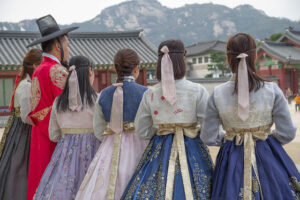As a foreigner in South Korea, you might feel overwhelmed by the plethora of questions asked of you by your hosts, including and especially, what your age is.
While it may seem like a rather personal question, in Korea, this is a critical element of ensuring that your hosts address you by the correct title.
This is a deeply-ingrained cultural norm that seeks to show high levels of respect to the addressee.
That’s why honorifics in Korean language are so important.
In this blog post, we’ll talk about some common customs in Korean culture and some of the titles that one may be assigned in order to show the appropriate levels of respect.
The art of pouring soju
There’s a Korean saying which identifies the “proper” amount to drink and it goes like this: “il bul, sam so, o ui, chil gwa.” Essentially, it means “don’t stop with one glass; three glasses are not enough; five glasses is a proper amount, and seven glasses is too much.”
With this in mind, it comes as no surprise that there’s a high consumption of hard liquors in Korea and getting drunk, and quickly at that, is a normal part of Korean culture.
One such hard liquor is soju. A see-through drink with a high alcohol content, it is perceived as an inexpensive way of getting drunk quickly.
In the West, drinking entails the pouring of a drink and handing it to your guests, who then proceed to enjoy the said drink.
In Korea, on the other hand, there are a set of rules and procedures to ensure that your drinking does not offend those around you; especially people of the older generation.
So, how does one pour and drink soju without causing offence?
The first step is to identify the most respected spot at a Korean drinking table. This is normally the place on the floor nearest to the fireplace or somewhere where one can sit against a wall and see the entrance door. This seat is reserved for your superiors or people who are older than you.
Once the seating has been taken care of, you’ll want to offer the first glass of soju to the oldest person first. The person pouring should pour the drink with both hands. The soju bottle should be held with the right hand, while your left hand should be placed under your right arm.
There are two other general “rules” for drinking and pouring soju, and they may be the most important ones for you to keep in mind. They are related to when the host proposes a drink to a guest, and when an elderly person offers a drink.
In the former case, the guest needs to pick up and hold their glass using both hands, while the host proceeds to pour the drink. Once poured, the guest needs to turn their head away from their host and consume the drink quickly. Instead of putting the glass down on the table once finished, the guest should offer their same glass to the host and pour them a drink as well. The glass should always be offered using the right hand.
Meanwhile, in the latter case, when an elderly person offers alcohol, the person on the receiving side should stand up, bow and accept the glass with both hands. After the elderly person has finished pouring, the younger person can sit down and drink. It’s considered inappropriate to drink before the elder person raises the glass and to decline a glass that such a person is offering.
The importance of Korean titles

With something as seemingly simple as pouring soju, it gets even more complicated when it comes to calling a Korean person by their proper title.
As mentioned above, a person’s age is critical in how you will be addressed and what cultural norms will be followed in order to ensure a respectful and professional relationship.
With over 19 honorific titles in Korea, it’s bound to get confusing, though!
The title of the person will depend on their age (even if they’re just a few months older than you), their relationship to you or their position in a formal environment.
For example, you may call an older male person “oppa”, which is literally translated as “older brother”. But, even in this case, there’s also the option of calling an older male “hyeong” or “hyung”.
Can you imagine how difficult it becomes when referring to a senior male or female, who might be your superiors in a company?
While there were previously eight levels of honorific titles in Korea, today, there are around four to six.
Honorifics start as early as kindergarten and not using the right title has been shown to have severe consequences, the least of which have been the severing of relationships due to the lack of respect.
In order to be successful in showing the appropriate levels of respect in Korea, avoid using the person’s first name.
However, if you do use a first name, follow this by the person’s title.
In order to follow the correct etiquette, use the person’s surname followed by their titles.
These may include, but are not limited to, some of the following:
회장님 (hoejang-nim) – Chairman/Chairwoman
이사님 (isa-nim) – Director
사원 (sawon) – Employee
Final thoughts
Korea is a beautiful country with a very rich culture and history.
It would be wise for you to be as prepared as possible when it comes to the proper forms of etiquette when pouring soju or addressing people of a higher rank or age than you.
This will help ensure you forge strong relationships with your Korean counterparts and have fulfilling conversations without offending anyone!